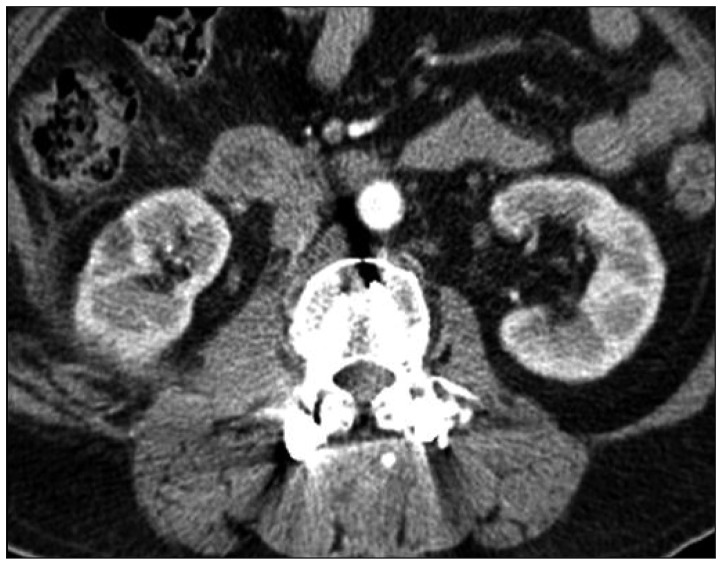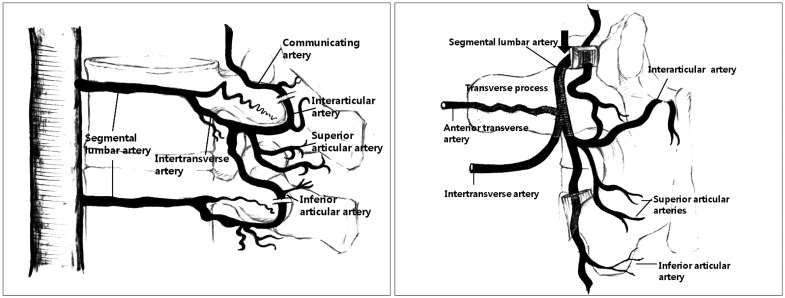J Korean Neurosurg Soc.
2013 Oct;54(4):344-346. 10.3340/jkns.2013.54.4.344.
Delayed Retroperitoneal Hemorrhage due to Lumbar Artery Pseudoaneurysm after Lumbar Posterolateral Fusion
- Affiliations
-
- 1Department of Neurosurgery, Research Institute of Clinical Medicine of Chonbuk National University Biomedical Research Institute of Chonbuk National University Hospital, Jeonju, Korea. spineeun@jbnu.ac.kr
- KMID: 1499342
- DOI: http://doi.org/10.3340/jkns.2013.54.4.344
Abstract
- A 55-year-old female patient presented with lower back pain and neurogenic intermittent claudication and underwent L3-L4 posterolateral fusion. To prepare the bone fusion bed, the transverse process of L3 and L4 was decorticated with a drill. On the 9th post-operative day, the patient complained of a sudden onset of severe abdominal pain and distension. Abdominal computed tomography revealed retroperitoneal hematoma in the right psoas muscle and iatrogenic right L3 transverse process fracture. Lumbar spinal angiography showed the delayed hematoma due to rupture of the 2nd lumbar artery pseudoaneurysm and coil embolization was done at the ruptured lumbar artery pseudoaneusyrm. Since then, the patient's postoperative progress proceeded normally with recovery of the hemodynamic parameters.
Keyword
MeSH Terms
Figure
Reference
-
1. Chan KT, Korivi N. Lumbar artery pseudoaneurysm in traumatic spinal cord injury : a case report. Arch Phys Med Rehabil. 2003; 84:455–457. PMID: 12638116.
Article2. Domenicucci M, Ramieri A, Lenzi J, Fontana E, Martini S. Pseudo-aneurysm of a lumbar artery after flexion-distraction injury of the thoraco-lumbar spine and surgical realignment : rupture treated by endovascular embolization. Spine (Phila Pa 1976). 2008; 33:E81–E84. PMID: 18303450.3. Hamid RS, ul HT, Chishti I, Azeemuddin M. Post traumatic avulsion of lumbar artery : a rare cause of retroperitoneal haemorrhage treated by glue embolization. J Pak Med Assoc. 2010; 60:487–489. PMID: 20527650.4. Lee JS, Kim CW, Suh KT. Lumbar artery injury combined with a transverse process fracture of the lumbar spine presenting with hypovolemic shock after a fall : a case report. J Korean Orthop Assoc. 2008; 43:400–403.
Article5. Lee KH, Park JH, Chung JW, Han JK, Shin SJ, Kang HS. Vascular complications in lumbar spinal surgery : percutaneous endovascular treatment. Cardiovasc Intervent Radiol. 2000; 23:65–69. PMID: 10656911.
Article6. Lee WJ, Eun JP, Choi HY, Lee JC. Retroperitoneal hematoma secondary to terminal branch of segmental artery injury during intertransverse discectomy through paramedian muscle splitting approach. J Korean Neurosurg Soc. 2004; 36:246–248.7. Nijenhuis RJ, Sluzewski M, van Rooij WJ. Iatrogenic lumbar pseudoaneurysm causing dural sac compression after spine surgery. J Neurosurg Spine. 2009; 10:585–586. PMID: 19558292.
Article8. Papadoulas S, Konstantinou D, Kourea HP, Kritikos N, Haftouras N, Tsolakis JA. Vascular injury complicating lumbar disc surgery. A systematic review. Eur J Vasc Endovasc Surg. 2002; 24:189–195. PMID: 12217278.
Article9. Santillan A, Patsalides A, Gobin YP. Endovascular embolization of iatrogenic lumbar artery pseudoaneurysm following extreme lateral interbody fusion (XLIF). Vasc Endovascular Surg. 2010; 44:601–603. PMID: 20675335.
Article10. Sclafani SJ, Florence LO, Phillips TF, Scalea TM, Glanz S, Goldstein AS, et al. Lumbar arterial injury : radiologic diagnosis and management. Radiology. 1987; 165:709–714. PMID: 3685349.
Article11. Siablis D, Panagopoulos C, Karamessini M, Karnabatidis D, Margariti S, Tepetes K, et al. Delayed diagnosis of a false aneurysm after lumbar arterial injury : treatment with endovascular embolization : a case report. Spine (Phila Pa 1976). 2003; 28:E71–E73. PMID: 12590222.
- Full Text Links
- Actions
-
Cited
- CITED
-
- Close
- Share
- Similar articles
-
- Massive retroperitoneal hemorrhage due to a tearing of common iliac vein complicating lumbar diskectomy: a case report
- Local Bone versus Autogenous Iliac Bone Graft for Posterolateral Lumbar Fusion in the Same Patient
- Comparison Between Allograft Mixed with Local Bone and Autograft in Posterolateral Lumbar Fusion
- Lumbar Artery Injury Combined with a Transverse Process Fracture of the Lumbar Spine Presentingwith Hypovolemic Shock after a Fall: A Case Report
- A Comparison of Posterolateral and Posterior Interbody Fusion in the Surgical Treatment of Lumbar Spondylolisthesis





